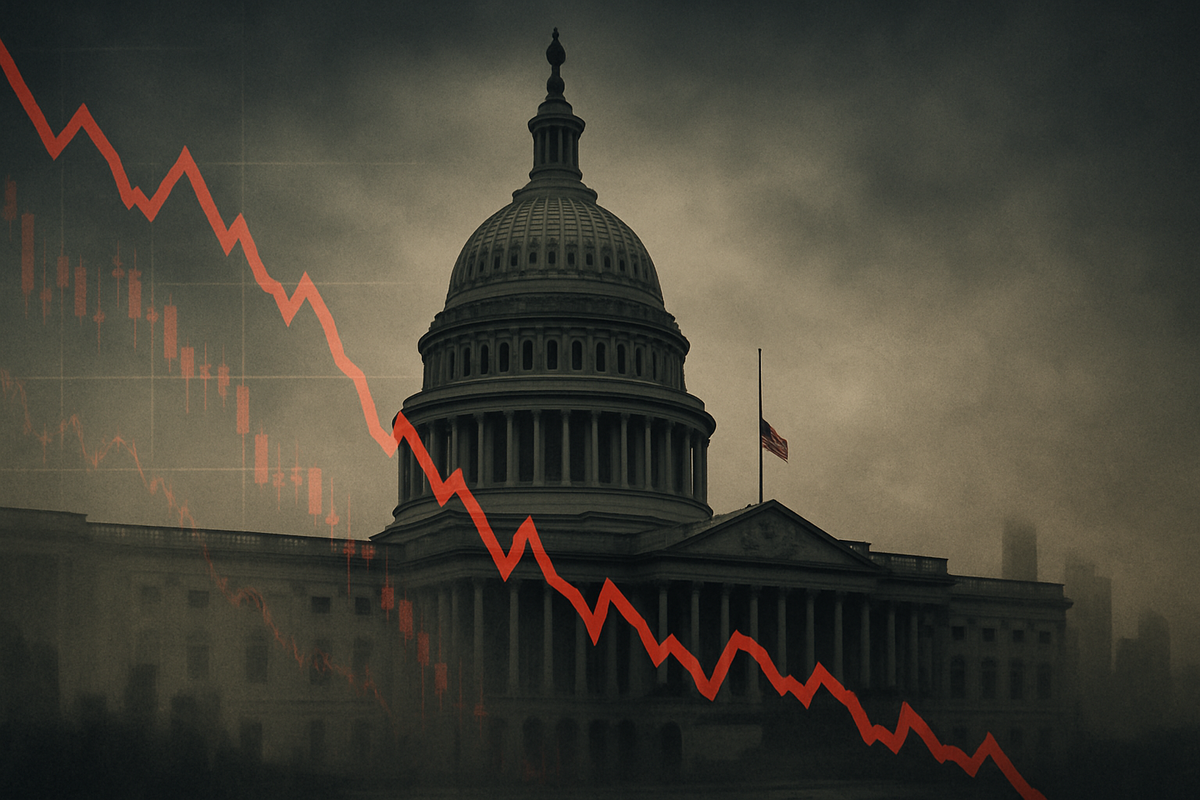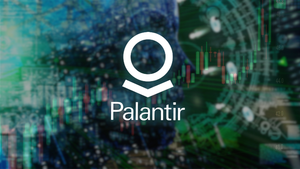
As the United States government enters a shutdown as of October 1, 2025, financial markets are bracing for a fresh wave of economic uncertainty and volatility. This immediate "risk-off" environment has seen an initial dip in stock futures and a sell-off in the broader market, though historical data suggests the long-term impact often remains limited. However, with crucial economic data delayed and hundreds of thousands of federal workers facing furloughs or working without pay, the immediate ripple effects on consumer spending and investor confidence are palpable, adding a new layer of complexity to an already delicate economic landscape.
The immediate implications extend beyond mere market jitters. The halt in essential government services and the impending financial strain on federal employees threaten to dampen consumer confidence and spending, which are vital engines of economic growth. Investors are grappling with a "blackout" of key economic indicators, making it challenging to assess the true health of the economy and anticipate monetary policy shifts. This scenario, set against a backdrop of existing inflation concerns, tight monetary policy, and geopolitical tensions, amplifies the potential for the shutdown to inflict more significant damage than previous, less fraught, episodes.
Detailed Coverage: A Nation Holds Its Breath as Government Stalls
The current US government shutdown, effective October 1, 2025, stems from an inability of Congress to pass appropriations bills or a continuing resolution to fund federal operations. This legislative deadlock, a recurring theme in American politics, has once again brought the machinery of government to a grinding halt. The specific details reveal a familiar pattern: non-essential government services are suspended, federal employees deemed "non-essential" are furloughed, and those deemed "essential" are required to work without immediate pay. Estimates suggest between 750,000 and 900,000 federal workers are impacted, leading to a daily economic cost of approximately $400 million in lost wages.
The timeline leading up to this moment was characterized by escalating political brinkmanship. Over the preceding weeks, negotiations between the White House and congressional leaders reportedly faltered over disagreements on spending levels and policy riders attached to appropriations bills. The contentious issues included funding for specific defense programs, social welfare initiatives, and border security measures. Despite last-minute attempts to avert the shutdown, including a series of late-night legislative sessions, a consensus could not be reached by the September 30 deadline. Key players involved include the President, the Speaker of the House, and the Senate Majority Leader, each representing factions with deeply entrenched positions, making compromise elusive. Reports also indicate that the Trump administration, in this instance, has directed agencies to consider more permanent layoffs if the shutdown prolongs, a move that could significantly intensify economic anxieties.
Initial market reactions have been predictably negative, though not catastrophic. On October 1, 2025, US stock futures for the S&P 500 and Dow Jones Industrial Average fell by approximately 0.6%, with Nasdaq 100 futures also retreating by 0.6%. This reflects a typical "risk-off" sentiment as investors seek safer havens. Gold prices, a classic indicator of uncertainty, surged to a record high of $3,895 per ounce. US Treasury rates also rallied, underscoring their appeal as a safe asset. The US dollar experienced initial weakness, as political instability tends to erode confidence in the nation's currency. While some sectors, like defense and healthcare, faced immediate selling pressure due to concerns over contract delays and program disruptions, the broader market's initial reaction has been one of cautious retreat rather than panic, with many investors recalling the historical tendency for markets to rebound post-shutdown.
The most significant immediate impact, beyond the financial markets, is the cessation of various government functions. National parks are closed, many federal agencies are operating with skeletal staff, and critical economic data releases from bodies like the Bureau of Labor Statistics and the Census Bureau are suspended. This data blackout is particularly concerning for investors and policymakers, including the Federal Reserve, as it obscures the real-time health of the economy, complicating decision-making regarding interest rates and monetary policy. This informational void, coupled with the direct economic hit from lost wages and reduced government services, fuels the overarching sense of economic uncertainty.
Companies on the Front Line: Winners and Losers in a Stalled Economy
A US government shutdown inevitably creates a distinct cleavage in the corporate landscape, delineating clear winners and losers based on their reliance on federal contracts, government services, or consumer sentiment. Companies heavily dependent on government spending often find themselves in the crosshairs, facing immediate disruptions and potential payment delays, while others, particularly those in defensive sectors or with minimal federal ties, may weather the storm more effectively.
Defense contractors are among the most vulnerable. Giants like Lockheed Martin (NYSE: LMT), Boeing (NYSE: BA), and Raytheon Technologies (NYSE: RTX) often see their stock prices dip as concerns mount over delayed contracts, halted payments, and potential project suspensions. While long-term contracts typically resume, the immediate uncertainty can cause significant short-term pressure. Similarly, companies providing IT services, consulting, or other specialized support to federal agencies, such as Booz Allen Hamilton (NYSE: BAH) or Science Applications International Corporation (NYSE: SAIC), face similar headwinds. Their revenue streams are directly tied to government appropriations, making them highly sensitive to funding lapses.
On the other hand, certain sectors and companies may exhibit greater resilience or even benefit from the "risk-off" environment. Consumer staples companies, such as Procter & Gamble (NYSE: PG) or Coca-Cola (NYSE: KO), tend to be more insulated as demand for their essential products remains relatively stable regardless of government operations. Utilities, like NextEra Energy (NYSE: NEE), also typically offer a defensive play, providing steady dividends and essential services. Furthermore, companies in the gold mining sector, such as Barrick Gold (NYSE: GOLD) or Newmont (NYSE: NEM), often see their valuations climb as gold serves as a traditional safe-haven asset during times of economic and political uncertainty, as evidenced by the recent surge in gold prices.
The impact also extends to companies indirectly affected by consumer confidence and spending. Retailers, restaurants, and travel companies might experience a slowdown as furloughed federal workers tighten their belts. While federal employees typically receive back pay after a shutdown, the immediate financial squeeze can lead to a temporary reduction in discretionary spending. Companies like Amazon (NASDAQ: AMZN), while diversified, could see a marginal impact on its retail segment, while travel companies such as Delta Air Lines (NYSE: DAL) or Marriott International (NASDAQ: MAR) might experience a dip in bookings if government-related travel is curtailed or consumer confidence wanes. Conversely, discount retailers like Walmart (NYSE: WMT) or Dollar General (NYSE: DG) might see a slight uptick in sales as consumers become more budget-conscious.
Ultimately, the duration of the shutdown is the most critical factor. A short-lived disruption typically results in temporary stock price fluctuations and minimal long-term damage to corporate earnings. However, a prolonged shutdown could lead to more significant and lasting impacts, forcing companies to re-evaluate staffing, project timelines, and even their long-term engagement with federal contracts. This uncertainty creates a challenging environment for corporate planning and investment, compelling businesses to adopt more agile strategies to mitigate risks associated with political gridlock.
Wider Significance: A Recurring Saga of Uncertainty
The current US government shutdown is not an isolated incident but rather a recurring symptom of deeper political polarization, fitting into a broader trend of legislative gridlock that has characterized American governance in recent decades. This event underscores the fragility of economic stability when contingent on political consensus, sending ripple effects far beyond the immediate federal workforce and financial markets. It highlights a systemic challenge where critical fiscal decisions become bargaining chips in ideological battles, ultimately impacting the nation's economic health and global standing.
The potential ripple effects on competitors and partners are significant. Internationally, a prolonged shutdown can erode confidence in the US as a reliable economic and political actor, potentially impacting trade negotiations, international collaborations, and the stability of global supply chains. For domestic competitors, particularly those in sectors reliant on government regulation or oversight, the slowdown or cessation of agency functions can create both challenges and, in some cases, temporary advantages. For instance, delays in regulatory approvals could hinder certain industries, while others might temporarily operate with less scrutiny. Partners of federal agencies, from research institutions to private contractors, face immediate operational disruptions and financial uncertainty, potentially forcing them to scale back activities or seek alternative funding.
Regulatory and policy implications are profound. A shutdown means that new regulations cannot be promulgated, existing ones may not be fully enforced, and critical agency functions like environmental reviews, food safety inspections, or financial oversight may be curtailed. This creates a vacuum that can lead to increased risks in various sectors. For instance, delays in FDA approvals could impact pharmaceutical companies (Pfizer (NYSE: PFE), Johnson & Johnson (NYSE: JNJ)), while a slowdown in EPA activities could affect energy and industrial firms. Furthermore, the inability to release crucial economic data hampers the Federal Reserve's ability to make informed monetary policy decisions, adding another layer of uncertainty to an already complex economic environment. This data blackout could lead to a less precise and potentially less effective response to emerging economic challenges.
Historically, government shutdowns have varied in their market impact. While the S&P 500 has, on average, posted positive returns during many shutdowns since 1976, the severity and duration have always been key determinants. The 2013 shutdown, for example, caused a temporary dip but ultimately had limited long-term market impact. The record-setting 35-day shutdown from late 2018 to early 2019, however, was more disruptive, contributing to a period of heightened market volatility. A critical distinction this time around is the existing economic context: high inflation, tight monetary policy, and rising geopolitical tensions. Unlike previous shutdowns that occurred during periods of relative economic strength, the current environment makes the economy more susceptible to the negative shocks of a prolonged government closure, potentially leading to a more severe and lasting impact on consumer and business confidence.
What Comes Next: Navigating the Fog of Uncertainty
The path forward from the current US government shutdown is shrouded in political and economic uncertainty, with both short-term disruptions and long-term strategic adaptations on the horizon. In the immediate future, the focus will remain squarely on Washington, D.C., as market participants closely monitor any signs of a breakthrough in congressional negotiations. Short-term possibilities include a swift resolution, potentially driven by public pressure or an emerging consensus on a temporary funding measure, which would likely lead to a quick market rebound as historical precedents suggest. However, a protracted stalemate, characterized by continued political intransigence, would deepen economic anxieties, potentially leading to more sustained market declines and a more significant erosion of consumer and business confidence.
In the long term, the recurring nature of these shutdowns may force more fundamental strategic pivots. Businesses, particularly those with significant government exposure, may need to diversify their revenue streams, build larger cash reserves to weather payment delays, or even reconsider their operational reliance on federal contracts. Companies in critical infrastructure sectors, for example, might explore public-private partnerships that are less susceptible to political funding cycles. For the broader economy, a prolonged shutdown could lead to a downward revision of GDP forecasts, an uptick in unemployment, and a potential delay in the Federal Reserve's monetary policy decisions due to the absence of reliable economic data, thereby extending the period of economic uncertainty.
Market opportunities and challenges will undoubtedly emerge from this turbulence. On the challenge side, increased volatility will make investment decisions more complex, and sectors directly impacted by government spending will continue to face headwinds. However, opportunities may arise for investors seeking defensive plays, such as high-quality dividend stocks in stable sectors (e.g., consumer staples, utilities) or safe-haven assets like gold and US Treasuries, especially if the shutdown persists. Furthermore, companies that demonstrate resilience and adaptability during this period, perhaps by leveraging technology to streamline operations or by tapping into diverse global markets, may emerge stronger in the post-shutdown landscape.
Potential scenarios range from a rapid, face-saving political compromise that minimizes economic damage, to a drawn-out battle that inflicts significant pain on federal workers, businesses, and the broader economy. A key outcome to watch for is how quickly furloughed federal employees receive back pay; delays here could exacerbate the impact on consumer spending. Another critical factor will be the Federal Reserve's response to the data vacuum and potential economic slowdown. Their communication and any emergency measures taken will be crucial in stabilizing market sentiment. Ultimately, this event serves as a stark reminder of the intricate link between political stability and economic prosperity, underscoring the need for greater legislative predictability to foster a robust and confident market environment.
Comprehensive Wrap-Up: Navigating the Storm
The US government shutdown of October 1, 2025, represents a significant, albeit familiar, disruption to the financial markets and the broader economy. The key takeaways from this event are multi-faceted: immediate market volatility driven by a "risk-off" sentiment, significant operational and financial challenges for federal workers and government-dependent businesses, and a critical data blackout that hampers informed economic decision-making. While historical precedents suggest that short shutdowns often have limited long-term market impact, the current economic climate—characterized by inflation, tight monetary policy, and geopolitical tensions—amplifies the potential for this shutdown to inflict more substantial and lasting damage on consumer and business confidence.
Moving forward, the market will remain highly sensitive to political developments in Washington. Investors should anticipate continued volatility, particularly in sectors directly tied to government contracts or regulatory oversight. The duration of the shutdown will be paramount; a swift resolution would likely trigger a rebound, while a prolonged impasse could lead to deeper economic scars and a more sustained period of market uncertainty. The Federal Reserve's response to the absence of key economic data and any potential economic slowdown will also be a critical factor in shaping market sentiment and policy expectations.
Final thoughts on the significance and lasting impact underscore the systemic nature of this issue. Recurring government shutdowns are not merely temporary inconveniences; they erode trust in governance, introduce unnecessary economic drag, and force businesses to adopt defensive strategies rather than focusing on growth and innovation. The lasting impact may be a further entrenchment of political polarization as an economic risk factor, compelling investors and businesses to factor in greater political uncertainty into their long-term planning. This event highlights the urgent need for a more stable and predictable legislative process to safeguard economic stability.
What investors should watch for in the coming months includes any progress in congressional negotiations, the eventual release of delayed economic data, and the Federal Reserve's assessment of the shutdown's impact on monetary policy. Furthermore, monitoring corporate earnings reports from companies with significant government exposure will provide real-time insights into the direct business consequences. Lastly, observing consumer spending trends and broader economic indicators will be crucial for gauging the shutdown's ripple effects on overall economic health. This content is intended for informational purposes only and is not financial advice





